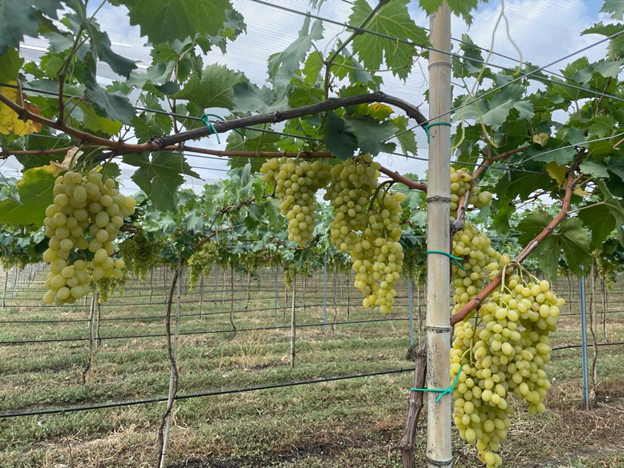Sartichala Vineyard Management LLC is one of the biggest growers of modern table grape varieties in Georgia. The company operates a 30-HA table grape vineyard featuring the most demanded varieties – Italia Muscat, Red Globe, Regal, and Crimson Seedless. The farm is located 40 km from Tbilisi next to Sartichala village.
Sartichala Vineyard Management LLC has harvested first table grapes this season thanks to the support of the USAID Agriculture Program co-funded advisory of the Italian agronomist who has been providing online and onsite consultancies in irrigation, fertigation, pruning, green operations, and pest management best practices. 60 tons of table grapes have been already supplied and sold at Carrefour, Spar, and Nikora supermarket chains with 30 more tons to be harvested by the end of the season.
EastFruit spoke with the company CEO – Konstantine Kvernadze – about the table grapes market in Georgia and the company’s plans.
– When did you start the table grapes business, what is the capacity of your orchard and when do you expect to reach it?
We see great potential for Georgian table grapes locally, but also on international markets. Prior to the start of the project, our team conducted a study of the local market in Georgia and assessed international trade opportunities regularly published by EastFruit. To be competitive on local but also international markets we decided to start with modern seedless varieties and extend the supply season with the ability to store grapes.
See also: Major breakthrough in Georgian table grapes exports
The vineyard was planted last year, in 2020, but before planting, the company shareholders visited Italian producers and designed the vineyard according to the newest technologies before planting. The vineyard is 30 hectares in total and this is the first year of production. The yield is 3-5 tons per ha, with an expected total yield of 850-900 tons next year.

– What is special in the production methods that allow you to reach this productivity?
-As European table grapes producers we grow grapes on pergolas, the whole vineyard is covered with anti-hail protection nets. An additional plastic cover will be applied in the future to prolong harvest time and protect grapes from seasonal rains. Our system allows us to fertigate and irrigate grapes exactly when it is needed. We use irrigation sensors (humidity controller), but do not have a weather station. However, it is a very important tool to have for a successful business in agriculture. In near future, we will set up a weather station in the field. The robust steel structure of the vineyard is designed to receive maximum yield.
– Given the decrease of tourists’ inflow due to pandemics, do you see the potential of growth in local consumption and how do you plan to sell your products in Georgia?
– Georgia is importing 1,500-2,000 tons of table grapes annually. Our goal is to replace imports on the local market. Our shareholders are closely working with Carrefour retail chain, thus 100% of our grapes are sold in organized retail. Branding is important to help increase the value of the product and we expect to introduce it once our farm is working at full capacity in 2022. Despite COVID-19 restrictions and decreasing tourism numbers, consumption has increased, instead of decreasing. In the country, there are up to 200-ha of table grape vineyards, and up to 50-ha are used to produce modern table grape vineyards with new varieties. In general, Georgian customers like to consume local products. When COVID-19 restrictions are over and tourists return, we believe table grape consumption will grow very fast.

-The season of table grapes in Georgia lasts from August to October, there is an opportunity to extend it with early varieties, greenhouse, and storage of table until March-April when imports are highest. Do you plan to introduce early varieties and/or greenhouse production for June-July and cold storage for winter months?
– All grapes in our vineyard are late varieties, we are planning to extend the supply time for grapes by keeping them in our cold storage, which is currently under construction, until the winter months. Cold storage is not only crucial in extending the shelf life of grapes, it is necessary for sorting them. We think it’s possible to cooperate with other producers according to market demand, so we are able to supply our clients as long as possible.
We may introduce early varieties in the future. This is dependent on the areas of the country which are suitable for early production. There are some regions that produce from July to late October.
– What international standards do you plan to introduce in your orchard and why?
We plan to introduce GlobalGAP for grape production and IFS for our sorting/packaging facility, which is necessary to supply our products to the EU market, primary Baltic states. As we see the future of our growth in the EU market, we are going to introduce those standards accordingly. We think that table grapes from Georgia have even more potential than wine from Georgia in the EU.
The use of the site materials is free if there is a direct and open for search engines hyperlink to a specific publication of the East-Fruit.com website.




